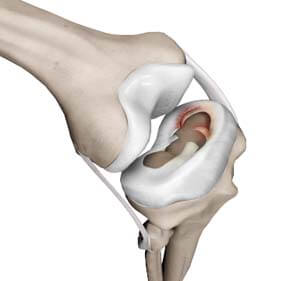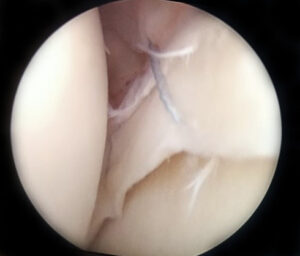Overview
What is a Meniscal Tear?
Before knowing meniscus tear, one must know that the knee has a piece of cartilage that stabilizes and cushions the joint. It shields the bones from deterioration. But all it takes to tear the meniscus is a twist of the knee. In rare instances of meniscal tear, a fragment of the torn cartilage detaches and is caught in the knee joint, locking it.
Both contact sports like football and non-contact sports demanding jumping and cutting, like volleyball and soccer, frequently result in meniscus injuries. They frequently occur concurrently with other knee injuries, such as anterior cruciate ligament (ACL) damage for which ACL Reconstruction surgery is the solution, and can occur when a runner abruptly changes direction while jogging. Meniscus tears are a special risk for older athletes since the meniscus weakens with age.

Symptoms
What are the symptoms of Meniscus Tear?
If you rupture the meniscus, you might hear a pop. Many sportsmen can continue playing with a tear in their knee, and most people can still walk on it. But the knee will progressively get more swollen and stiff over two to three days.
These are the most typical signs of a meniscus tear:
- Pain,
- Stiffness, and
- Edema
- Your knee locking or catching
- The feeling of your knee buckling
- Unable to fully extend your knee’s range of motion
How can the Tear be prevented?
Since meniscus tears are typically the consequence of an accident, they are difficult to prevent. However, a few safety measures may reduce the likelihood of a knee injury. You ought to:
- Do frequent exercises to maintain the strength of your thigh muscles.
- Before participating, engage in mild exercises to warm up.
- Allow your body to recover from workouts.
- Your risk of injury may rise if your muscles are tired.
- Verify that your shoes fit properly and provide adequate support.
- Retain adaptability.
- Don’t increase the intensity of your training suddenly.
- Implement adjustments gradually.
How would one identify it?
Your orthopedist will perform a complete medical history and evaluation of the knees if a meniscus tear is suspected. MRI and X-rays may also be ordered to confirm the diagnosis and assess the knee joint further.
Risks & Complications
Risks
Factors that increase the likelihood of a torn meniscus include engaging in activities that entail forceful twisting and pivoting of the knee, particularly among athletes participating in contact sports like football, or sports involving frequent pivoting like tennis or basketball. Additionally, as you age, the wear and tear on your knees heighten the risk of a torn meniscus, as does being overweight.
Complications
Complications arising from a torn meniscus may include sensations of the knee giving way, difficulty in normal knee movement, or enduring knee pain. Additionally, there may be an increased risk of developing osteoarthritis in the affected knee.
Treatment
How do you treat a torn meniscus?
At first, treatment usually starts without surgery, depending on what kind of tear you have and where it is.
If your tear is linked to arthritis, it might get better over time if you treat the arthritis, so surgery might not be needed. And many tears that aren’t making your knee get stuck or stop moving usually start feeling better over time without surgery.
Your doctor might suggest:
- Rest: Avoid doing things that make your knee hurt, especially anything that makes you twist, turn, or pivot your knee. If the pain is really bad, using crutches can help take the pressure off your knee and help it heal.
- Ice: Putting ice on your knee can help with pain and swelling. Use a cold pack, frozen veggies, or a towel filled with ice cubes for about 15 minutes at a time, and keep your knee raised. Do this every 4 to 6 hours for the first day or two, then as often as you need.
- Medicine: Over-the-counter pain relievers can also help with knee pain.
Physical therapy can make your knee and leg muscles stronger to support your knee better.
Surgery might be needed if your knee still hurts even after therapy, or if it gets stuck sometimes. Sometimes, especially for kids and younger adults, doctors can fix a torn meniscus with surgery.
If the tear can’t be fixed, the doctor might trim the meniscus with surgery, possibly using a tiny camera called an arthroscope. After surgery, you’ll need to do exercises to make your knee stronger and more stable.

